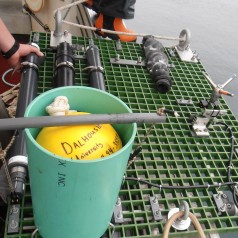Instrument recovery using acoustic releases

In July 2012, I had the opportunity to conduct fieldwork in Grand Passage, Nova Scotia. This tidal channel lies between Brier Island and Long Island, along the Digby Neck, and is proposed for in-stream tidal turbine development. We collected acoustic measurements from a bottom-mounted frame with a hydrophone on it.
The greatest moment of suspense every day was when we had to recover the frame. This could only occur during the short time window of low slack tide, as the currents were too great to safely recover at any other time. To recover, an on-board instrument sent an acoustic command to the releases on the frame, and this initiated electrolytic erosion on a hoop of metal. The corrosion of the metal hoop set loose a bungee chord that held down a buoy, causing the buoy and line to float to the surface, and allowing for the frame to be hauled up. However, the buoy may not always surface; signals may not be have been effectively received, the batteries on the releases may have died, or shell hash could have lodged the buoy.
If the frame was not successfully recovered, there could have be delays in field plans, we would have had to hire SCUBA divers to manually release the buoy, or, in the worst case, we could have lost our expensive hydrophones (oh no!). It was always a great relief when the yellow buoy was spotted!


